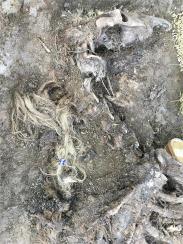Journal of Archaeological Science: Reports Pub Date : 2021-12-04 , DOI: 10.1016/j.jasrep.2021.103262 Tuija Kirkinen , Johanna Honka , Daniela Salazar , Laura Kvist , Markku Saastamoinen , Karin Hemmann

|
Everyday objects manufactured from raw materials of animal origin, such as skin, hair and bone, are innumerable in cultural historical museums and private collections. Besides their value as memoirs of past techniques, livelihoods and communities, they are a unique source for studying past animal populations by means of molecular analysis.
Here, we deal with horse mane and tail hair, a type of predecessor of modern synthetic material utilized, for example, for brushes, strings, tennis rackets, ropes, textiles, dolls’ hair, rocking horses, and filling. By investigating the presence and quality of DNA in horsehair, we have studied the origins of the Finnhorse, the only native horse breed in Finland. Degradation of DNA in old samples is an issue that needs to be considered when selecting material for DNA analysis. For assessing the usability of historical artefacts for DNA-based studies, we study how DNA is preserved in horsehair and how well DNA can be isolated from 50 to 150-year-old artefacts, raw material bundles and archaeological finds. We investigate how the properties of hair and sample storage conditions affect the concentration of DNA extracts and success in Polymerase Chain Reaction (PCR).
Our analysis showed that historical hair shafts, stored in various environments and used for multiple purposes, are of sufficient quantity and quality for amplification by PCR. Therefore, their value for the research of past animal populations should be noticed when curating cultural historical collections. We also provide advice for the storage conditions for hair samples.
中文翻译:

确定影响从芬兰马历史毛发中分离出的 DNA 浓度的不同预测因子
由动物源性原材料制成的日常物品,如皮肤、毛发和骨骼,在文化历史博物馆和私人收藏中数不胜数。除了作为过去技术、生计和社区回忆录的价值外,它们还是通过分子分析研究过去动物种群的独特来源。
在这里,我们处理马鬃和马尾毛,这是现代合成材料的一种前身,用于例如刷子、线、网球拍、绳索、纺织品、玩偶的头发、摇马和填充物。通过调查马毛中 DNA 的存在和质量,我们研究了芬兰马的起源,芬兰马是芬兰唯一的本土马品种。旧样品中 DNA 的降解是选择 DNA 分析材料时需要考虑的问题。为了评估历史文物在基于 DNA 的研究中的可用性,我们研究了 DNA 是如何保存在马毛中的,以及从 50 到 150 年前的文物、原材料束和考古发现中分离 DNA 的程度。
我们的分析表明,储存在各种环境中并用于多种用途的历史毛干具有足够的数量和质量,可用于 PCR 扩增。因此,在策划文化历史收藏时,应注意它们对过去动物种群研究的价值。我们还为头发样品的储存条件提供建议。



























 京公网安备 11010802027423号
京公网安备 11010802027423号